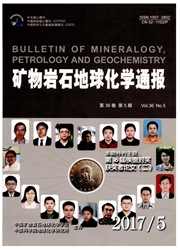

 中文摘要:
中文摘要:
铊是13种优先控制的有毒有害重金属元素之一,研究微生物与铊之间的相互作用有重要的理论意义和应用价值。在黔西南滥木厂铊矿区采集土壤和沉积物,借助平板筛选法在铊浓度为1000 mg/L水平筛选得到九株高耐受性菌株,用于真菌对铊的胞外吸附作用实验,并采用液体发酵法考察真菌对铊的胞外吸附作用,实验设计了1000 mg/L、1200 mg/L和1500mg/L三种铊处理水平,借助ICP-MS检测分析样品的铊含量,以此计算吸附效率。结果表明,三种处理水平中,真菌菌株对铊的吸附效率为4.63%~16.89%,且随着环境中铊浓度的上升,菌丝体(或菌丝球)生物量明显减少,导致吸附效率的下降;真菌对常量元素如钙、钠、钾的吸附与对铊的吸附呈显著正相关。这表明真菌细胞对钙、钾的吸附方式可能与对铊的吸附方式类似。
 英文摘要:
英文摘要:
Thallium is in the thirteen priority heavy metals list of USEPA.It's of great significance to study the interaction between thallium and microboes.At 1000 mg/L Tl level,nine strains with high tolerance of thallium were screened from the Lanmuchang thallium-mineralised area in the southwest Guizhou province,and were applied to adsorption experiments using submerged culture.In the present work involved three treatments of 1000,1200l and1500 mg/L Tl concentrations,and the levels of the heavy metals were detected by ICP-MS.The results showed that the rates of Tl being adsorbed varied from 4.63 to 16.89% for the nine strains.The increments of thallium content in the cultures resulted from decreasing of biomass and decreasing of adsorption rates of Tl.The adsorption amount of Tl correlated positively with the adsorption amounts of the major elements,i.e.Ca,K and Na,which could be concluded that the adsorption mechanism of Tl is similar to those of Ca,Na and K.
 同期刊论文项目
同期刊论文项目
 同项目期刊论文
同项目期刊论文
 期刊信息
期刊信息
